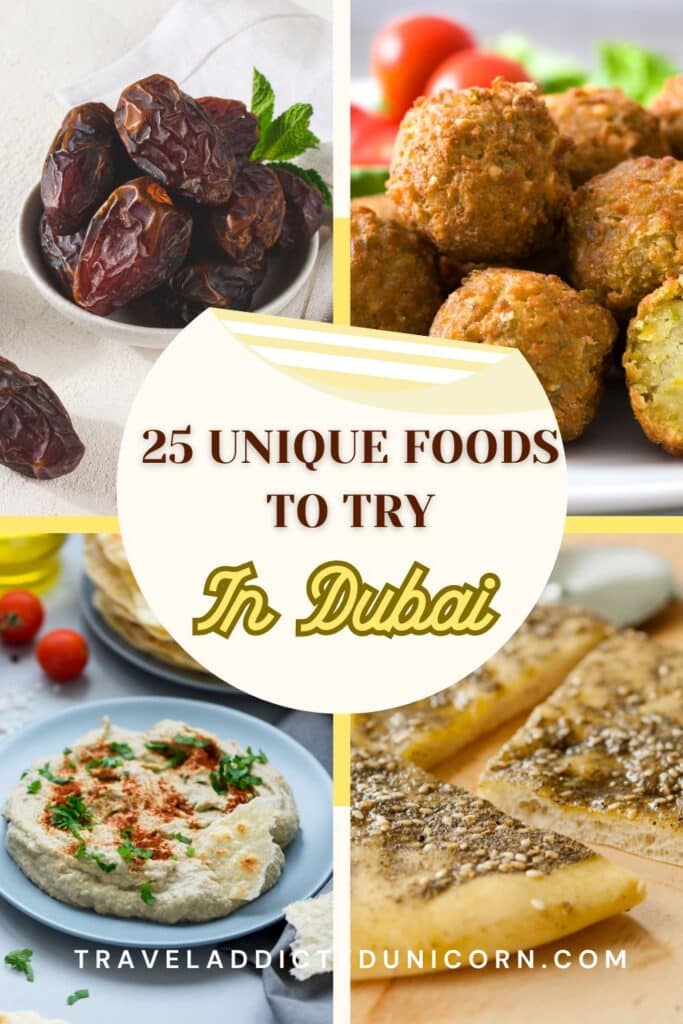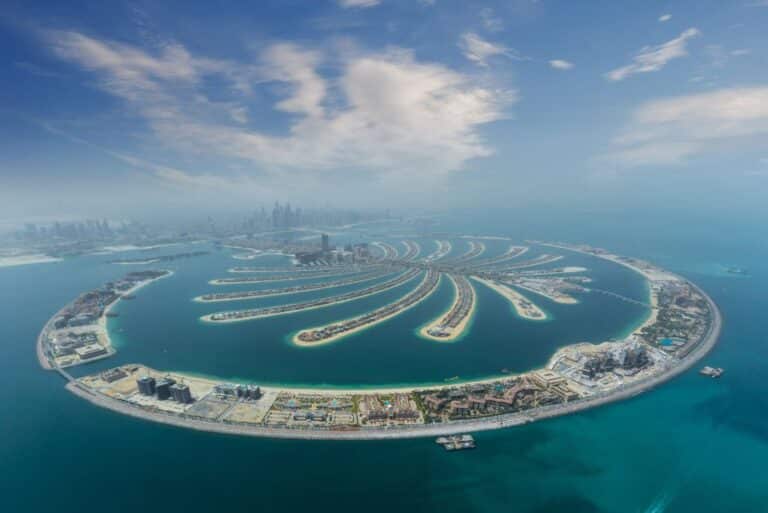25 Unique Foods To Try In Dubai


Are You Traveling To The UAE And Wondering What Are Some Unique Foods To Try In Dubai?
So what are some unique foods to try in Dubai?
Dubai’s culinary scene offers a diverse array of dishes, reflecting the city’s blend of cultures and influences.
In this blog post, we’ll take a closer look at some unique foods to try in Dubai.
Join us as we explore the distinct flavors of Dubai’s food scene, with a focus on discovering new tastes and culinary traditions.
My favorite thing about traveling is having the chance to try the local cuisine and needless to say, there are plenty of yummy foods to try in Dubai.
So without further ado: “25 Unique Foods To Try In Dubai”.
Unique Foods To Try In Dubai
First, let’s take a look at some of the most unique foods you can find in Dubai.
1. Camel Meat
In Dubai, camel meat is occasionally used in traditional dishes, offering a unique taste of local cuisine.
One of the things you can try is Camel Burger.
Which is ground camel meat formed into a patty and served in a bun with lettuce, tomato, onion, and condiments, similar to a beef burger.
Also, you can try Camel Shawarma which is thinly sliced camel meat seasoned with Middle Eastern spices.
Then, it is wrapped in flatbread with salad and sauce, similar to traditional shawarma.
Camel Kebabs are available as well. They are skewers of marinated camel meat grilled and often served with rice, salad, and sauces.
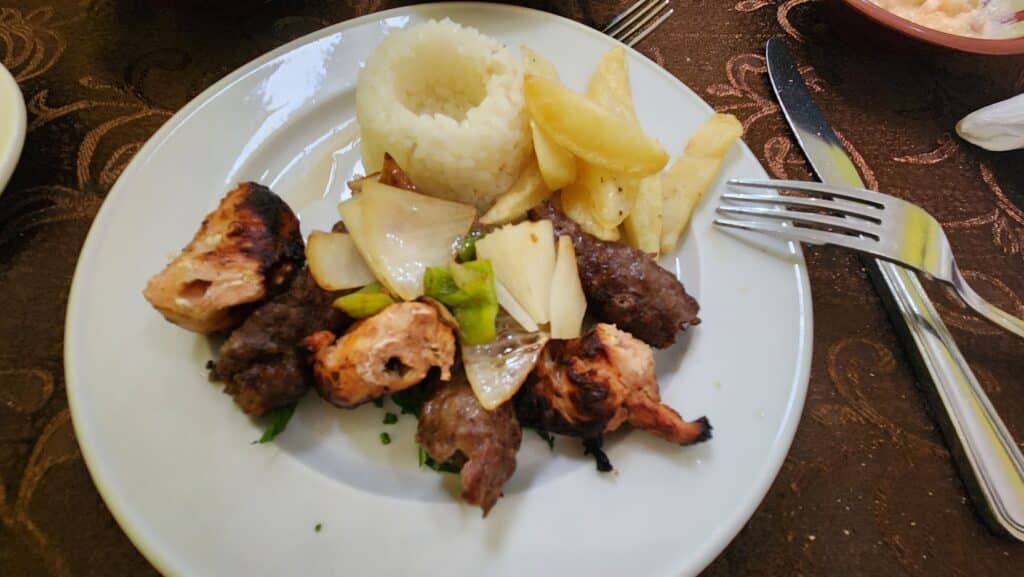
In addition, you can sometimes find Camel Biryani.
Which is a flavorful rice dish that features camel meat and a blend of aromatic spices, similar to traditional biryani but with camel as the protein.
It’s important to note that camel meat dishes are not as common or widely available as other types of meat in Dubai – they are more like delicacies or specialties.
Visitors interested in trying camel meat dishes may need to seek out specific restaurants that specialize in traditional Emirati cuisine.
2. Camel Milk Products
Something else to try in Dubai is Camel Milk Products. There are various products that use camel milk, such as camel milk chocolate, ice cream, and cheese.
I tried camel milk on its own and the taste is thicker and saltier than cow milk.
Personally, I am not a huge fan of cow milk so to me the camel milk didn’t taste that great.
Definitely give it a try though!
Also, we tried camelccino, which is a regular cappuccino with camel milk instead of cow milk.
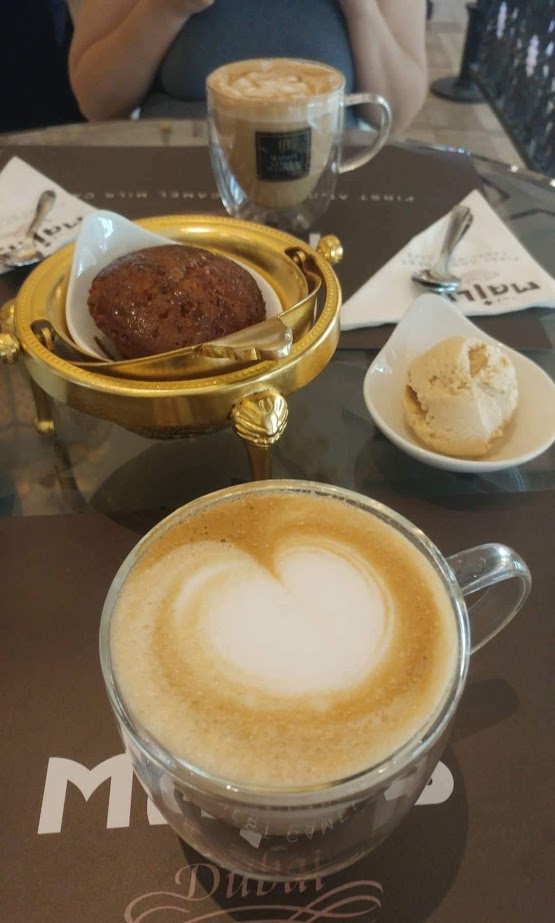
It tastes pretty good compared to the camel milk on its own. So if you are not brave enough, try it in your coffee first.
In addition, we tried different flavored camel milk chocolates such as pistachio, dates, hazelnuts, etc.
Overall, it’s definitely something unique to try and it makes cool presents to bring to your family and friends.
We tried camel milk products in a cafe called The Majlis, located in Dubai Mall, on the ground level. We had their date cake and their ice cream.
**Unfortunately, it appears that the cafe has closed permanently and I am not able to find a new address for it.
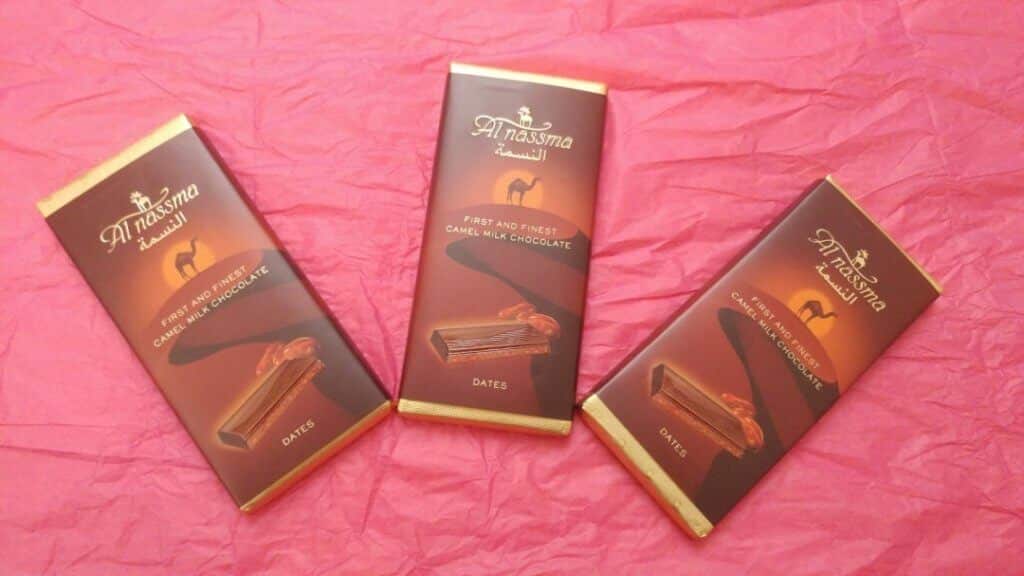
👉 If you prefer to do a food tour, here are a couple of options:
Dubai Aladdin Tour: Souks, Creek, Old Dubai and Tastings
Private Dubai Local Food Tour
3. Shawarma
Shawarma is a beloved Middle Eastern street food dish that is popular in Dubai and enjoyed by locals and visitors alike.
It consists of thinly sliced meat, typically lamb, chicken, beef, or a combination.
The cook marinates the meat in a blend of spices and seasonings, such as garlic, cumin, paprika, and vinegar.
Then they stack the marinated meat on a vertical rotisserie and slowly roast it until it becomes tender and flavorful.
Shawarma is a popular dish in Dubai, commonly served as a sandwich or wrap.

Where the thinly sliced meat is wrapped in a flatbread, such as pita or Arabic bread, along with a variety of accompaniments.
These may include shredded lettuce, sliced tomatoes, onions, pickles, and a choice of sauces, such as tahini, garlic sauce, or spicy chili sauce.
Shawarma sandwiches are typically popular as a quick and satisfying meal on the go.
In addition, they are available at street food stalls, casual eateries, and fast-food restaurants throughout Dubai.
The combination of tender, flavorful meat with fresh vegetables and tangy sauces makes shawarma a favorite street food option in Dubai’s vibrant culinary scene.

4. Balaleet
Balaleet is a traditional Emirati breakfast dish that combines sweet and savory flavors.
It consists of vermicelli noodles cooked with sugar, spices, and sometimes eggs, creating a unique and flavorful dish.
The vermicelli noodles are typically boiled until tender, then sautéed with butter, sugar, and ground cardamom to add sweetness and fragrance.
In some variations of Balaleet, beaten eggs are added to the mixture, creating a custard-like texture and adding richness to the dish.

The eggs are often cooked until set, then mixed with the sweetened vermicelli noodles to create a creamy breakfast.
You will usually enjoy Balaleet alongside a savory omelet made with onions, tomatoes, and spices.
Providing a contrast of flavors and textures on the breakfast plate.
It is popular with locals and visitors alike for its delicious taste and its role as a comforting and satisfying start to the day in the United Arab Emirates.

5. Machboos
Machboos, also known as Kabsa, is a traditional and popular dish in Emirati cuisine.
It is a fragrant rice dish with meat (usually chicken, lamb, or fish) and includes a blend of aromatic spices.
The dish entails cooking the meat with onions, tomatoes, and a variety of spices such as cardamom, cinnamon, cloves, and bay leaves until tender and flavorful.

The rice is then cooked separately with the same spices and broth from the meat, resulting in a flavorful and aromatic base.
Once the rice is cooked, it is layered with the cooked meat and served hot, often garnished with fried onions, raisins, almonds, or fresh herbs like parsley and cilantro.
Machboos is known for its rich and complex flavors, as well as its hearty and comforting nature.

6. Halloumi
Halloumi is a semi-hard, brined cheese that originates from Cyprus but is also popular in Dubai and throughout the Middle East.
It is made from a mixture of sheep’s milk and/or goat’s milk, although cow’s milk can also be used.
One of the distinctive features of halloumi is its high melting point, which allows it to be grilled or fried without losing its shape.
Halloumi has a dense and rubbery texture with a salty flavor, and you can eat it fresh or lightly cooked.
You will usually add halloumi to your salads, sandwiches, and wraps, or enjoy it as a side dish or appetizer.

Grilled or fried halloumi develops a crispy exterior while remaining soft and slightly chewy on the inside.
Making it a popular choice for vegetarian and meatless meals.
Halloumi is a versatile ingredient that adds flavor and texture to a variety of dishes, and it is enjoyed by locals and visitors alike for its unique taste and culinary versatility.
I love Halloumi cheese, it is salty and chewy but it doesn’t have an overpowering taste.
Mix Halloumi and Za’atar (below) and you get a yummy combination.
🦄 Related blog posts:
Is Dubai Worth Visiting? Things To Do & Reasons To Visit
Old Dubai: Al Fahidi, Dubai Creek & The Souks In Deira
My Experience Skydiving In Dubai
Dubai Hidden Gems: 17 Places You Absolutely Must Explore
Complete Dubai Metro Guide
10 Things To Know Before Going To Dubai
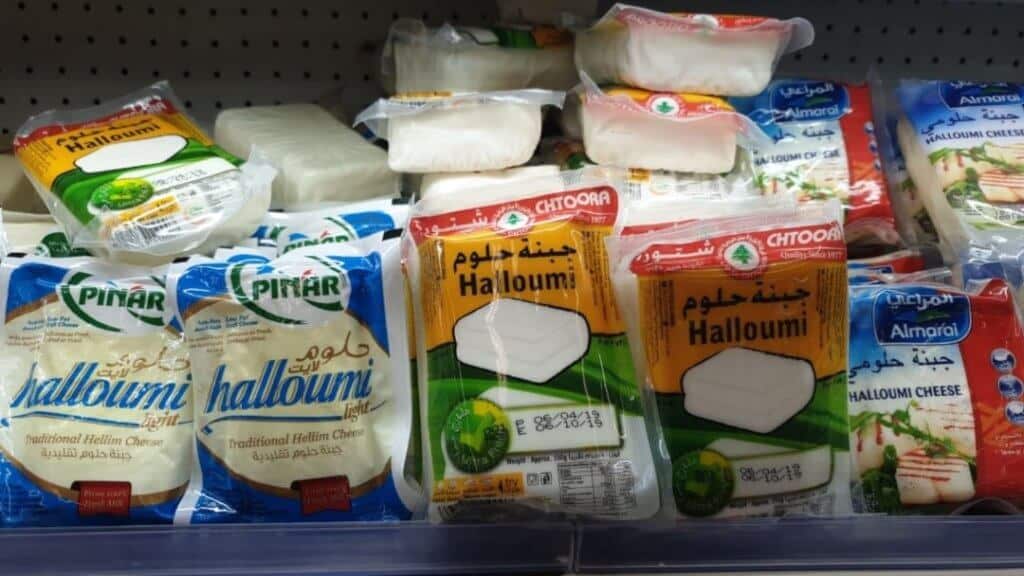
7. Dried Fruits And Nuts
In Dubai, a wide variety of dried fruits and nuts are available.
As a staple in Middle Eastern cuisine, dates are widely available in Dubai in various varieties.
Including Medjool, Deglet Noor, and Khidri. You can eat them as a snack, use them in cooking, or serve them with coffee or tea.
Also, dried apricots are popular in Dubai and are often enjoyed as a sweet and tangy snack or used in desserts, salads, and savory dishes.
Dried figs are popular for their sweet and chewy texture. You can eat them on their own or incorporate them into baked goods, salads, and cheese platters.

Raisins are a versatile dried fruit that is used in a wide range of dishes, including baked goods, salads, rice dishes, and desserts.
In addition, prunes are rich in flavor and are often enjoyed as a nutritious snack or used in cooking and baking.
Pistachios, almonds, peanuts, and cashews are popular in Dubai and are enjoyed as a snack or used in various Middle Eastern dishes, desserts, and confections.
These dried fruits and nuts can be found in traditional souks (markets), supermarkets, specialty stores, and online retailers throughout Dubai.
I love pistachios, cashews, dates and figs!
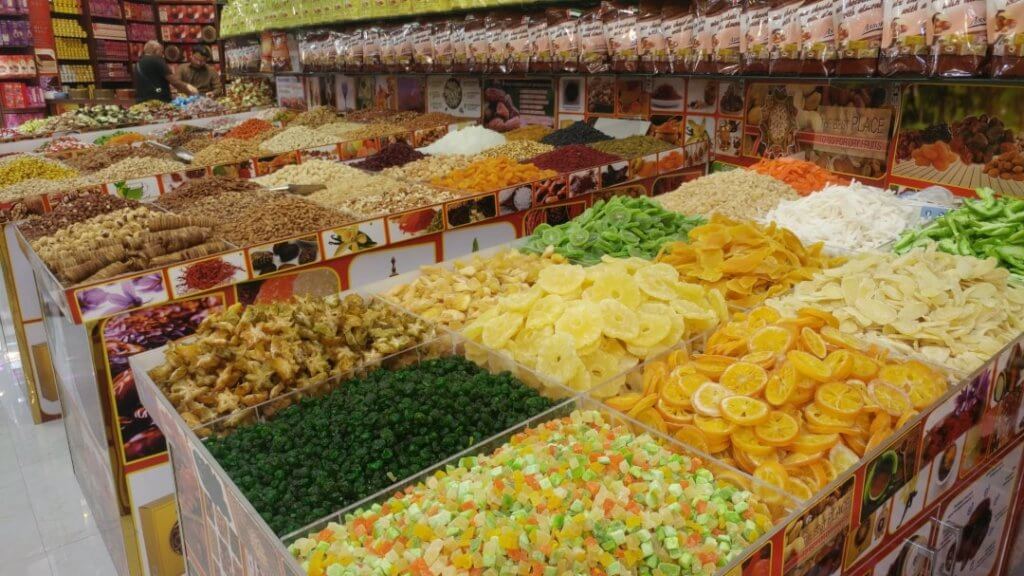
Unique Foods To Try In Dubai – Salads/Apps
In this section, we will check out some interesting salads and app that you can get in Dubai.
8. Fattoush
Fattoush is a traditional Middle Eastern salad that originates from Lebanon but is also popular in Dubai.
It is popular for the vibrant flavors and refreshing combination of vegetables and herbs.
Fattoush typically includes a variety of chopped vegetables such as tomatoes, cucumbers, radishes, and green onions, along with crisp romaine lettuce and fresh herbs like parsley and mint.
One of the defining features of fattoush is the addition of toasted or fried pieces of pita bread, which add a crunchy texture to the salad.
The pita bread is torn into bite-sized pieces and either toasted in the oven or fried until golden and crispy.

Fattoush is dressed with a tangy and zesty dressing made from olive oil, lemon juice, and sumac, a tart and citrusy spice that adds depth of flavor to the salad.
It is a light and refreshing salad that is perfect for hot climates like Dubai’s.
You can have it as a side dish or appetizer alongside grilled meats, kebabs, or falafel.
Its combination of crisp vegetables, fragrant herbs, and crunchy pita bread makes it a favorite among locals and visitors alike.
I absolutely love Fattoush salad, and highly recommend it!

9. Tabbouleh
Tabbouleh, also spelled tabouli, is a traditional Middle Eastern salad.
It is known for its fresh and vibrant flavors, as well as its light and nutritious ingredients.
It is typically made with finely chopped parsley, tomatoes, onions, and bulgur wheat.
To prepare tabbouleh, the parsley, tomatoes, and onions are finely chopped and mixed together in a bowl.
The bulgur wheat is soaked in water to soften it before being drained and added to the bowl of vegetables.

Afterwards, the salad is dressed with a simple vinaigrette made from olive oil, lemon juice, salt, and pepper, which adds brightness and tanginess to the dish.
Tabbouleh is popular for the refreshing taste and light texture, making it a popular choice for hot climates like Dubai’s.
You can enjoy it as a side dish or appetizer alongside grilled meats, kebabs, or falafel.
Also, locals and visitors alike enjoy tabbouleh for its delicious and nutritious qualities.
Sometimes they add pomegranate seeds to the tabbouleh salad and it tastes great.

10. Hummus
Hummus is a popular Middle Eastern dip or spread that is widely popular in Dubai and throughout the region.
It is made from cooked and mashed chickpeas (garbanzo beans), blended with tahini (sesame seed paste), lemon juice, garlic, and olive oil.
The mixture is seasoned with salt and often garnished with additional olive oil, paprika, or chopped parsley.
In Dubai, people usually eat hummus as an appetizer or mezze (small dishes served as appetizers or starters) in restaurants, cafes, and households.

It is typically accompanied by warm pita bread or Arabic flatbread for dipping.
Also, you can enjoy it with fresh vegetables such as cucumbers, carrots, or bell peppers.
Hummus is famous for having a creamy texture, nutty flavor, and versatility, making it a staple in Middle Eastern cuisine.
You can enjoy it as a dip for bread or vegetables, as a spread in sandwiches or wraps, or as a side dish alongside grilled meats or falafel.
In Dubai, hummus is appreciated for its delicious taste and its role as a nutritious and satisfying part of meals and snacks.

11. Falafel
Falafel consists of small, deep-fried balls or patties made from ground chickpeas or fava beans, mixed with herbs, spices, and onion.
The mixture is formed into balls or patties and then deep-fried until crispy and golden brown.
In Dubai, falafel is popular as a street food snack or as part of a larger meal.
Such as stuffed into pita bread or flatbread along with fresh vegetables, tahini sauce, and pickles to create a falafel sandwich or wrap.

Also, it could be served on a platter with hummus, tahini sauce, salad, and pickles as part of a mezze (small dishes served as appetizers or starters).
Falafel has a crispy exterior and tender interior, as well as it, has a savory and aromatic flavor profile.
It is a popular vegetarian option for both locals and visitors in Dubai for its delicious taste and satisfying texture.

12. Baba Ganoush
Baba ganoush is a creamy and flavorful dip made primarily from roasted eggplant (aubergine), tahini (sesame seed paste), lemon juice, garlic, and olive oil.
The roasted eggplant is blended with the other ingredients to create a smooth and creamy texture.
In Dubai, people enjoy baba ganoush as an appetizer or mezze (small dishes served as appetizers or starters) in restaurants, cafes, and households.
You would usually eat it alongside warm pita bread or Arabic flatbread for dipping.

Also, it could be accompanied by fresh vegetables such as cucumbers, carrots, or bell peppers.
Baba ganoush is popular for having rich and smoky flavor, as well as having a creamy texture.
It is a versatile dish that can be enjoyed as a dip, spread, or side dish.
In addition, it is appreciated for its delicious taste and its role as a nutritious and satisfying part of Middle Eastern cuisine.

13. Stuffed Grape Leaves
Stuffed grape leaves, known as “warak enab” in Arabic, consist primarily of grape leaves.
They are filled with a flavorful mixture of rice, herbs, and sometimes minced meat, such as lamb or beef.
To prepare stuffed grape leaves, grape leaves are typically blanched to soften them before being stuffed with the rice and herb filling.
The filling usually includes ingredients such as cooked rice, onions, tomatoes, parsley, mint, and spices like cinnamon, allspice, and nutmeg.
Sometimes, pine nuts and currants are also added for additional texture and flavor.

Once filled, the grape leaves are rolled tightly into small parcels and cooked by either simmering or steaming them.
You do that in a flavorful broth or sauce until the rice is cooked through and the grape leaves are tender.
Stuffed grape leaves are often served as part of a mezze spread or as an appetizer in Dubai and other Middle Eastern countries.
You can enjoy them warm or at room temperature and are popular for their delicate flavors and satisfying texture.
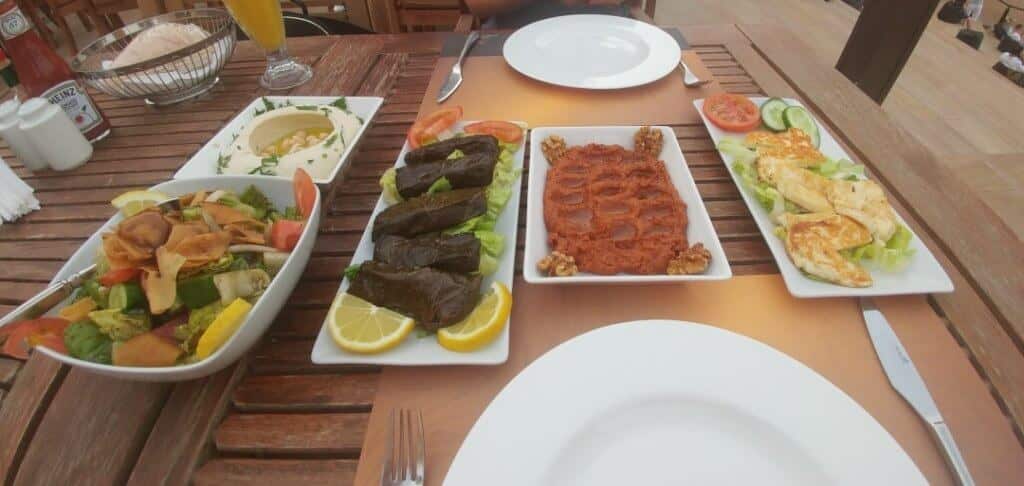
🦄 Related blog posts:
Dubai: Miracle Garden, Global Village & Dubai Frame
Dubai: Burj Khalifa, Dubai Mall & Fountain Show
My Experience Having Dinner In The Sky In Dubai
Dubai: Burj Al Arab, Souk Madinat & Palm Jumeirah
What Are People From Dubai Called?
Dubai Desert Safari: Everything You Need To Know
Unique Foods To Try In Dubai – Drinks
Let’s take a look at some drinks that can go with your yummy food.
14. Karak Tea
Karak tea, also known as “Karak chai” is a popular spiced tea that originated in South Asia and is widely consumed in the Middle East, including Dubai.
It has a rich, creamy texture and bold flavors, making it a favorite beverage among locals and expatriates alike.
To prepare Karak tea, you brew black tea leaves in hot water until the liquid is strong and aromatic.
Then, you can mix in evaporated milk or condensed milk to achieve a creamy consistency.
In addition, you can add a sweetener such as sugar or honey to balance the spices and enhance the flavor.
The tea is then infused with a blend of aromatic spices, including cardamom, cloves, cinnamon, and sometimes saffron, which give it a distinctively warm and comforting taste.
Karak tea is typically served piping hot in small cups or glasses.

Making it perfect for enjoying during social gatherings, as a morning pick-me-up, or as a soothing beverage after a meal.
Its popularity stems from its delicious flavor, as well as its ability to provide comfort and warmth, especially during colder months.
Overall, Karak tea is a beloved beverage in Dubai and throughout the Middle East.
Offering a delightful blend of spices and creamy sweetness that appeals to a wide range of tastes.
I saw it on the menu of a few restaurants/cafes and sometimes you can find a small booth where they are selling it (kind of like a lemonade stand).
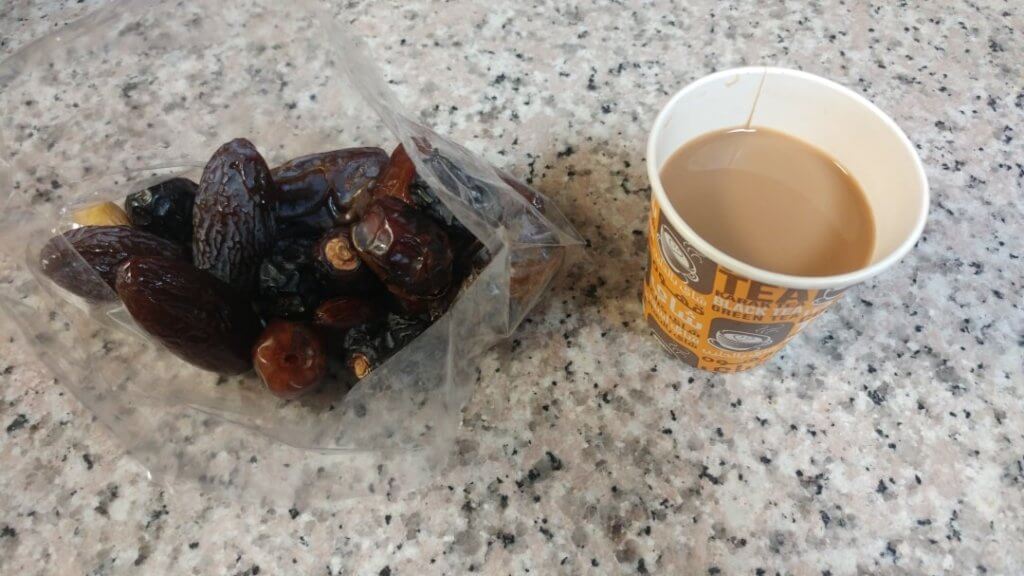
15. Laban/Ayran
Laban, also known as “Ayran” in some regions, is a traditional Middle Eastern drink made from yogurt, water, and salt.
To make Laban, plain yogurt is diluted with water to achieve a consistency similar to that of milk.
Some variations may include adding a pinch of salt for flavor, although this is optional.
The mixture is then stirred or whisked until smooth and well combined.
It is different than ordinary yogurt because you can actually pour it into a glass and drink it instead of eating it with a spoon.
Laban is known for its refreshing taste and cooling properties, making it a popular choice, especially during hot weather.
It can be enjoyed on its own as a refreshing beverage or served alongside meals to complement savory dishes.

In addition to its refreshing taste, Laban is also valued for its nutritional benefits.
It is rich in probiotics, which are beneficial bacteria that support gut health and digestion.
Also, Laban is a good source of protein, calcium, and other essential nutrients found in yogurt.
You can find Laban in any grocery store in the UAE.
There are flavored ones (strawberry, berries, pineapple) or you can simply enjoy the plain one.
Therefore, Laban is a versatile and nutritious beverage that is enjoyed by many in Dubai and throughout the Middle East for its delicious taste and health benefits.
I personally like Laban a lot, but it seems like it is extremely fattening.
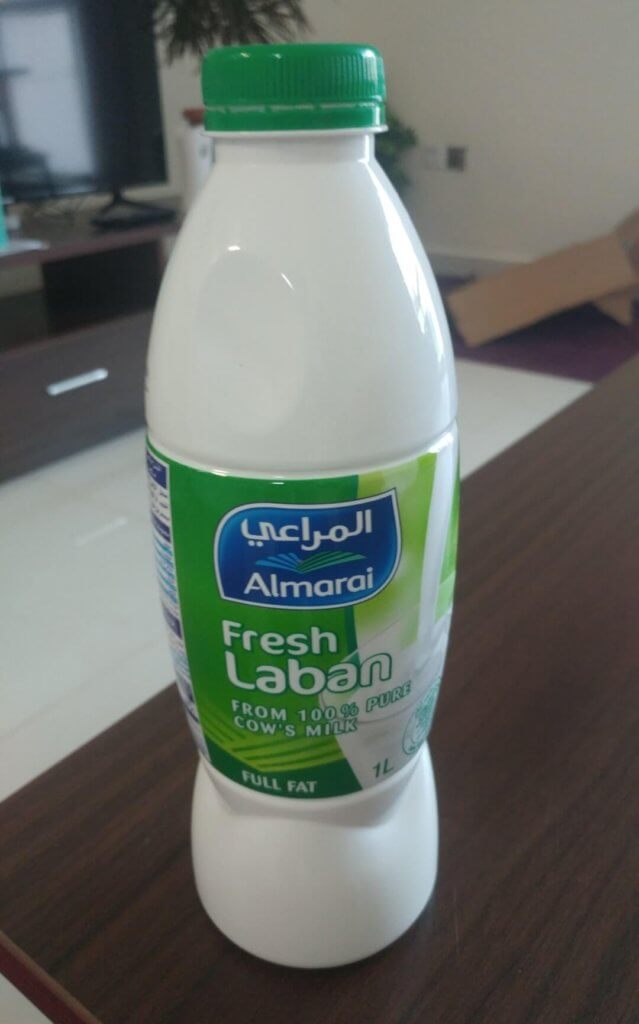
16. Arabic Coffee
Arabic coffee, also known as “Gahwa” or “Qahwa,” is a traditional coffee brewed in the Middle East, including the United Arab Emirates (UAE).
It holds significant cultural importance and is often served as a gesture of hospitality during social gatherings, celebrations, and special occasions.
Arabic coffee is prepared using a blend of Arabica beans, which are ground to a fine consistency.
The coffee is brewed in a special pot called a “dallah” or “finjan”.
Along with water and sometimes cardamom or other spices, depending on personal preferences and regional variations.

One of the distinguishing features of Arabic coffee is its strong, aromatic flavor and the absence of sugar or milk in its preparation.
It is traditionally served in small cups called “finjan” or “demitasse cups,” which are often ornately decorated and designed to hold only a few sips of coffee.
In addition, Arabic coffee is often accompanied by small, sweet treats such as dates or pastries, enhancing the overall experience of enjoying this beverage.
Drinking Arabic coffee is not only about the taste but also about the social ritual and hospitality that surrounds it, making it an integral part of Arab culture and customs.
Arabic coffee is popular for having rich flavor, cultural significance, and the sense of warmth it fosters during social interaction.

17. Freshly Squeezed Juices
In Dubai, you can find a wide variety of freshly squeezed juices available at juice bars, cafes, and street vendors throughout the city.
Freshly squeezed orange juice is a classic choice and is widely available in Dubai. It’s refreshing, tangy, and packed with vitamin C.
Pomegranate juice is a popular and nutritious option known for its antioxidant properties and sweet-tart flavor.
Refreshing and hydrating, watermelon juice is a favorite in Dubai, especially during the hot summer months.
Cucumber juice is light and refreshing, perfect for quenching thirst and staying hydrated.
In addition, freshly squeezed lemonade is a refreshing and zesty option, often sweetened with honey or sugar.

Made from ripe mangoes, freshly squeezed mango juice is sweet, tropical, and bursting with flavor.
You absolutely must try the watermelon, pomegranate, and mango flavours.
I probably drank thousands of liters of pomegranate juice in Dubai and I regret nothing lol.
A lot of places do a mix of different fruit juices to create a mocktail (non-alcoholic beverage).
Also, a lot of the mocktails have mint or ginger in them as well.
With the city’s diverse culinary scene and emphasis on fresh, healthy ingredients, you’re sure to find a wide range of delicious options to suit your taste preferences.
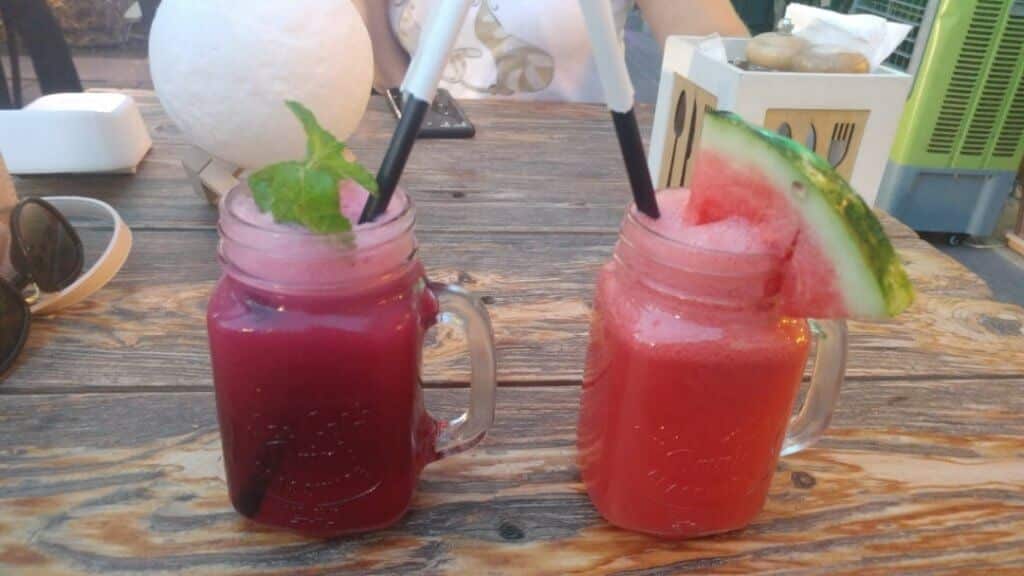
👉 If you prefer to do a food tour, here are a couple of options:
Dubai Aladdin Tour: Souks, Creek, Old Dubai and Tastings
Private Dubai Local Food Tour
Unique Foods To Try In Dubai – Spices
Let’s take a look at some of the spices that you need to try in Dubai.
18. Saffron
The highly prized spice saffron comes from the stigma of the Crocus sativus flower, commonly known as the saffron crocus.
So you can imagine how many flowers you need in order to get only a few grams.
It is widely regarded as one of the most expensive spices in the world due to the labor-intensive process required to harvest it.
Saffron has a vibrant crimson color and a distinctively rich and aromatic flavor, often described as floral, slightly sweet, and earthy with hints of honey and hay.
Saffron is used primarily as a seasoning and coloring agent in various cuisines, particularly in Middle Eastern, Mediterranean, and South Asian dishes.
People often add it to rice dishes, seafood meals, risotto, stews, soups, sauces, desserts, and beverages to infuse them with its distinctive flavor and vibrant color.
The dishes become golden brown after adding saffron to them.

Moreover, people value saffron for its potential health benefits, such as its antioxidant properties and potential mood-enhancing effects.
Due to its high cost and labor-intensive cultivation process, saffron is often sold in small quantities and used sparingly.
It is typically available in thread-like strands or ground into powder form.
We tried a saffron latte, which turned out to be quite sweet.
During our two-week stay, we didn’t come across any saffron-infused dishes, likely because of the spice’s high cost.
We inquired at several Arabic restaurants in hopes of discovering saffron-based dishes, but unfortunately, we had no success.
However, we did notice a few places offering saffron lattes, which means these might be easier to find.
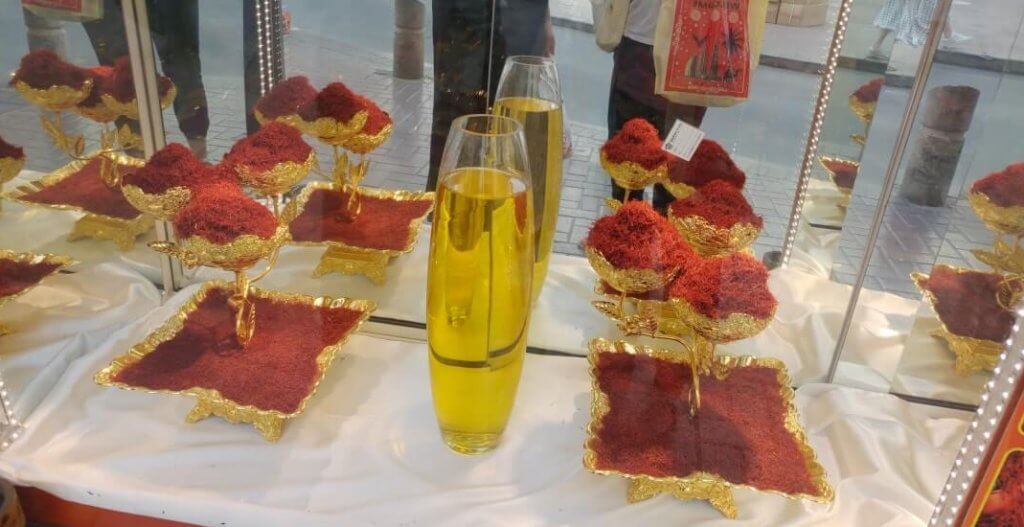
19. Za’atar
Za’atar is a versatile Middle Eastern spice blend that is popular in the cuisine of countries like UAE, Lebanon, Syria, and Jordan.
It consists of a combination of dried herbs, typically including thyme, oregano, marjoram, and sometimes savory.
Za’atar has a fragrant aroma and a savory, slightly tangy flavor profile, with herbal notes and a nutty undertone.
People usually use it for seasoning various dishes, including meats, vegetables, salads, and bread.
In Middle Eastern cuisine, za’atar is often mixed with olive oil to create a paste or spread, which is then used as a dip for bread or as a marinade for grilled meats.

Also, Za’atar is sprinkled over labneh (strained yogurt), soups, fish, hummus, or other dips, adding depth of flavor and texture.
Additionally, it can be used as a topping for flatbreads or mixed into dough for baked goods, such as za’atar bread or mana’eesh, a traditional Middle Eastern flatbread.
Za’atar is prized for its unique flavor profile and versatility, adding a distinctive taste of the Middle East to a wide range of dishes.
We tried it on some mana’eesh bread (flatbread) with some cheese.
You can find Za’atar flavored dishes everywhere; they even had some in the grocery store for take-out.
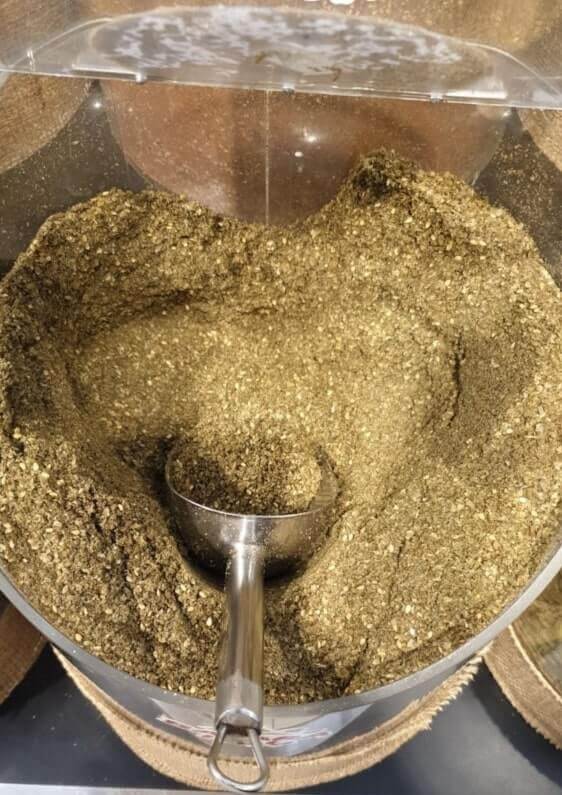
20. Baharat
Baharat is a versatile spice blend popular in Middle Eastern and Gulf cuisine.
The word “baharat” translates to “spices” in Arabic, and the blend typically consists of a variety of ground spices, herbs, and aromatics.
However, the exact composition can vary depending on regional preferences and family recipes.
Some common ingredients found in baharat include black pepper, cumin, coriander, cinnamon, cloves, cardamom, nutmeg, and allspice.

These spices are ground and blended together to create baharat, which is used to season a wide range of dishes.
Including meat, poultry, rice, stews, soups, and vegetable preparations.
Baharat adds depth, complexity, and warmth to Emirati cuisine, enhancing the flavor profile of traditional dishes with its aromatic and flavorful characteristics.
Unique Foods To Try In Dubai – Sweets/Desserts
If you are in the mood to try some Arabic sweets, this section is for you.
21. Dates/Chocolate-Covered Dates
Dates are the fruit of the date palm tree and are widely popular in the Middle East, North Africa, and other regions with warm climates.
If you like dates, you are in the right place as the United Arab Emirates is famous all over the world for its dates.
They are oval-shaped fruits with wrinkled, brown skin and a sweet, caramel-like flavor.
Dates have a high natural sugar content and are often perfect as a snack or as a natural sweetener in various recipes.
Chocolate-covered dates are a delicious treat made by dipping whole or pitted dates in melted chocolate.
Typically dark chocolate or milk chocolate, and then allowing them to cool and harden.
Sometimes, the chocolate-covered dates are also rolled in chopped nuts, coconut flakes, or other toppings for added texture and flavor.
The combination of the sweet, chewy dates and the rich, creamy chocolate creates a delightful contrast of flavors and textures.

You can enjoy them as a dessert or snack and you can find them in specialty food stores, chocolate shops, and online retailers.
Additionally, chocolate-covered dates are sometimes served as part of holiday celebrations or special occasions, adding a touch of sweetness to the festivities.
We purchased a variety of dates, and each type we tried was absolutely delicious.
Personally, I found the chocolate-covered dates super tasty and ended up eating several bags of them.
I highly recommend trying dates, whether on their own or dipped in chocolate.
Keep in mind that dates are naturally pretty sweet, and I find it hard to eat large quantities in one sitting.
So, if you’re unsure about how much you can eat, it’s best not to purchase large quantities.
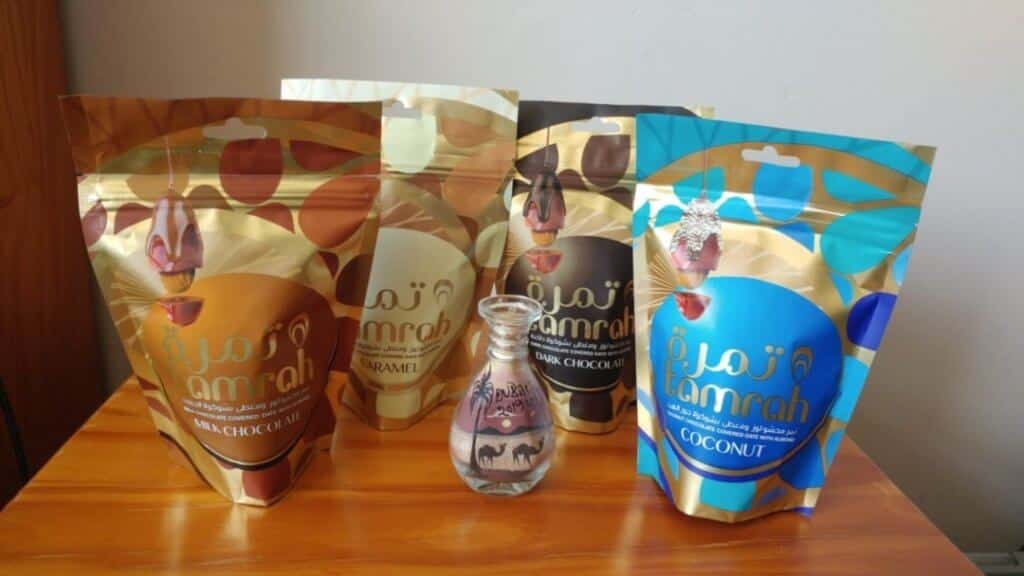
22. Kunafa
Kunafa, also spelled “kunafeh” or “knafeh,” is a popular Middle Eastern dessert made with shredded phyllo dough (also known as kataifi).
It is layered with a creamy cheese filling, typically made from ricotta or similar cheese.
The dessert is then baked until the phyllo dough becomes crispy and golden, while the cheese filling melts and becomes gooey.
Once baked, kunafa is soaked in a sugar syrup flavored with rose water or orange blossom water, adding sweetness and aroma to the dessert.
Sometimes, the top of the kunafa is garnished with chopped pistachios or other nuts for added texture and flavor.

Kunafa is popular for having contrasting textures and flavors, with the crispy exterior of the phyllo dough complementing the soft, creamy cheese filling and sweet syrup.
It is often served warm and is a popular dessert for special occasions, celebrations, and gatherings throughout the Middle East.
Also, variations of kunafa exist across the region, with different countries and regions adding their own twists to the classic recipe.
Some versions use different types of cheese or nuts, while others may incorporate additional flavorings or ingredients.
Overall, kunafa is famous for its indulgent taste and rich texture, making it a special dessert in Middle Eastern cuisine.

23. Luqaimat
Luqaimat are small, deep-fried dumplings that are popular in the United Arab Emirates and other Gulf countries.
These yummy treats are made from a simple dough consisting of flour, yeast, sugar, water, and sometimes saffron or cardamom for added flavor.
The dough is typically mixed until smooth and then allowed to rise before being portioned into small balls.
Once shaped, the dough balls are deep-fried until they achieve a golden-brown color and a crispy exterior while remaining soft and fluffy on the inside.

After frying, the Luqaimat are traditionally drizzled with date syrup (dibs) or honey, which adds a delightful sweetness and sticky texture.
You can enjoy Luqaimat as a dessert or snack during special occasions, celebrations, and festivals, such as Ramadan and Eid.
Therefore, they are popular for their irresistible combination of crispy, golden dough and sweet, syrupy coating.
Making them a favorite treat among locals and visitors alike in Dubai and throughout the UAE.
👉 If you prefer to do a food tour, here are a couple of options:
Dubai Aladdin Tour: Souks, Creek, Old Dubai and Tastings
Private Dubai Local Food Tour

24. Muhallabia
Muhallabia is a traditional Middle Eastern milk pudding.
This creamy dessert is made from a few simple ingredients, primarily milk, sugar, and a thickening agent such as cornstarch or rice flour.
Muhallabia is often flavored with aromatic ingredients such as rose water or orange blossom water, which impart a delicate floral fragrance to the pudding.
To prepare Muhallabia, the milk is heated with sugar until the sugar dissolves.
Then the thickening agent is gradually added to create a smooth, creamy consistency.
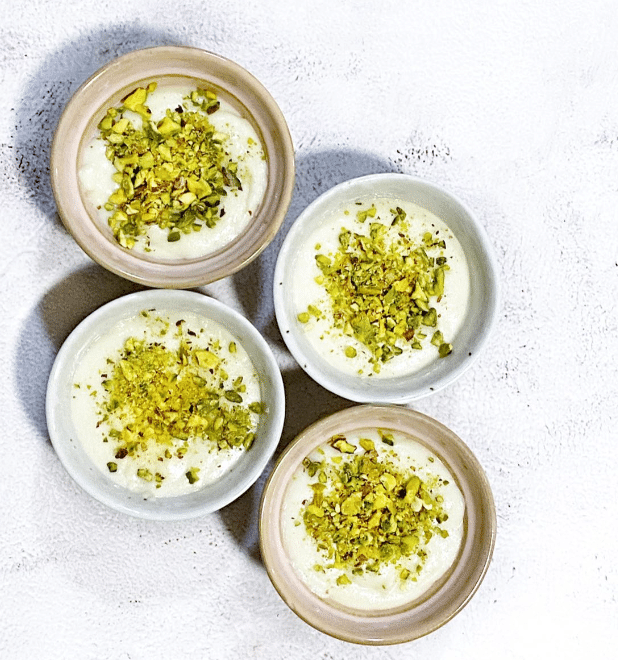
The mixture is then simmered over low heat until it thickens, stirring constantly to prevent lumps from forming.
Once thickened, the pudding is poured into serving dishes and left to cool before being refrigerated until set.
Muhallabia is typically served chilled and could be garnished with chopped nuts such as pistachios or almonds for added texture and flavor.
In addition, it is often sprinkled with ground cinnamon or cardamom to enhance its aromatic profile.
People enjoy Muhallabia as a refreshing dessert or sweet treat.
🦄 Related Abu Dhabi blog posts:
Is Abu Dhabi Worth Visiting? Things To Do & Reasons To Visit
Where To Stay In Abu Dhabi: 15 Best Hotels
Abu Dhabi: Qasr Al Watan, Emirates Palace & Observation Deck At 300
Abu Dhabi: Sheikh Zayed Mosque, Louvre & Heritage Village
Is Abu Dhabi In Dubai? Where Is Abu Dhabi?
Is Abu Dhabi Safe To Visit?
25. Baklava
Baklava is a sweet and rich pastry made from layers of thin phyllo (filo) dough, butter or oil, and chopped nuts, typically walnuts, pistachios, or almonds.
The layers of dough and nuts are stacked, with each layer brushed with melted butter or oil to create a flaky and crispy texture.
Once assembled, the baklava is baked in the oven until golden and crisp.
After baking, a sweet syrup made from sugar, water, and sometimes lemon juice or rose water is poured over the hot baklava.
Allowing it to soak into the layers and infuse the pastry with sweetness and moisture.

Baklava has a rich, sweet flavor and delicate, flaky texture.
In addition, it offers a delightful contrast between the crispy layers of dough and the soft, nutty filling, enhanced by the aromatic syrup.
It is popular for its indulgent taste in Dubai and throughout the Middle East.
I like baklava but I find it quite sweet and can only eat a few pieces at a time.

Conclusion: 25 Unique Foods To Try In Dubai
In conclusion, exploring the diverse culinary landscape of Dubai offers a delightful journey through many unique and delicious foods.
From traditional Emirati dishes like Balaleet to international delights with a local twist, there is no shortage of culinary adventures awaiting visitors.
Whether savoring the rich flavors of Machboos or indulging in the sweetness of Kunafa, each dish tells a story of cultural heritage, innovation, and the vibrant spirit of Dubai’s culinary scene.
Embarking on a culinary exploration of these 25 unique foods promises not only a feast for the senses.
But also a deeper appreciation for the rich diversity and flavors that Dubai has to offer.
